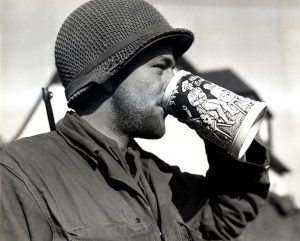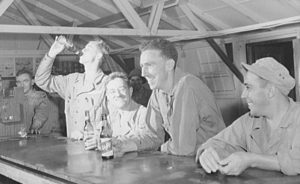by Zane Foley
Craft beer plays a role in all our lives and in very significant ways. We’re craft beer people after all. As business owners, non-profit organizers, and craft beer enthusiasts, we are the people who move the needle of craft beer history. But we often relate the role of beer to merrymaking and celebration. In other words, good times of peace.
It might be as simple as looking forward to that first refreshing sip of suds after a long day at work or happily finding ourselves rejoicing with friends in the ceremony of throwing a few back on the weekend. Nonetheless, we forget there are times throughout human history and our own lives, where those sips of suds are participating in different types of ceremonies – ceremonies of war.
In the month of May, we celebrate a holiday specifically for military observance. Usually on this day, we simply watch the planes fly over baseball stadiums and clap in the streets as we line up for parades. But these men and women often are pouring some out for their fallen brethren, remembering those who fell in battle and after receiving insufficient care and support as veterans in the aftermath, find beer a familiar comfort.
While Beer is for Everyone does not promote war or violence upon the world or upon another human being, we do find the role of beer within the history of war a fascinating intersection both anthropologically speaking and in contrast to how we normally enjoy beer.
We hope to honor this year’s Memorial Day with such an article, for within the horrors of war, through the rubble and deep loss, daily miracles and acts of goodness prevail. It makes us wonder, how often when beer is present in wartime do these moments resemble the rituals of peace. And perhaps, they keep the hope of peace alive in such times. What we’ve found as well is just how much war has impacted beer as vice versa.
War Led to the Creation of the Indian Pale Ale
Nearly anyone who considers themselves a beer enthusiast has tasted an Indian Pale Ale (the famous IPA) at one point or another. Honestly, it’s probably one of your favorite beer choices. But did you know the Indian Pale Ale was invented as an effect of war? As a way to keep soldiers happy while on long fighting campaigns away from home.
Let’s go back to the late 16th century and early 17th century; England had the largest Navy in the world and just lost 13 New England colonies to something called The American Revolution. But the imperialist British army was still planting flags around the world – including India, Africa, Spain, and even Australia. With large armies of men around the world, like many cultures who came before the British, a beer ration helped keep these men content and motivated (even loyal). But as these English armies invaded farther and farther lands, they needed a way to keep the Beer traveling thousands of miles from going bad.

We’re talking about a journey from England to India which takes 6 months to go just one way. While porters and stouts could last the voyage, there was nothing quite refreshing about a porter on a hot Indian summer day, where temperatures reach well over 110 degrees. The history books tell us (although they don’t always agree) that a London brewer named George Hodgson changed one simple thing about the Pale Ale to increase the life and brewing process of the more refreshing English beer. The Smithsonian Magazine has detailed some of the accounts and breweries who were first to join in on the new IPA beer made famous from soldiers stationed in the far corners of the world.
But it was Hodgson who added freshly-picked hops and not just a handful, but lots and lots. The increase expanded the brewing process and although it made it more bitter, it increased the alcohol content – which is why today it is often referred to as the most bang for your buck at the local bar. The increased alcohol content counteracted beer destroying bacteria and resembled the already present barley wine. People soon found out these beers could not only last months, but years. As you might have guessed, the Indian Pale Ale went from England to India, hence the name.
WWII Might Have Saved American Brewing
There may be no better way to put this into perspective than with the quote from John Strange, Prohibitionist and Lt. Gov. of Wisconsin:
“We have German enemies across the water. We have German enemies in this country, too. And the worst of all our German enemies, the most treacherous, the most menacing, are Pabst, Chlitz, Blatz and Miller.”
This comes at a time during the largest war in human history, where Americans renamed sauerkraut to “Liberty Lettuce” in protest of Germany and states like Iowa declared speaking German in public to be against the law. German-American breweries were quickly forced to adapt their German writing and German labels to English written labels, and even changed flavors to more English flavors.
Traditional American brewers seized the opportunity to separate themselves from the German-American brewing companies, who had long been dominating the bars and brew houses with their superior crafted and tasting beer. Red, white, and blue patriot style branding, labeling and everything else you can think of where these American brew houses were able to express patriotism became a staple in their marketing. It was also a major blow to prohibition (which if you know your history was less than a decade behind WWII). Drinking American-made beers became a symbolic form of supporting your country, ensuring beer and brewing would, as Lincoln would have said, never perish from this earth.

Additionally, with thousands of young men overseas, many of which under legal drinking age and even with only 3.2 percent of US beers being shipped over to the military – young men were indulging in their military beer rations once their Coca Cola rations ran out – developing a taste for beer that would last throughout their lives. Companies like Budweiser and Miller were among the mass produced brands that helped the world get through ‘the big one’.
It should be noted as well, these young men enjoyed beer while on recreation island or away from the front lines. They indulged in merry times while the idea they could possibly pass away within the week loomed over them. It was detailed by a 1941 issue of Brewer’s Digest presented by the National WW2 Museum, these military men presented an opportunity, “to cultivate a taste for beer in millions of young men who will eventually constitute the largest beer-consuming section of our population.”
The U.S. Army Made “Lager” America’s Beer
Throughout the complex military history of the United States, beginning with the American Revolution, and through the Civil War and both World Wars, what endures is a complex cultural exchange between Irish and German immigrants who enlisted and brought with them their beers.

For instance, during the American Civil War, the Northern Union Army had German and Irish immigrants fighting in their ranks, who themselves had their own supply of beer that when it ran out, sometimes led to quarrels with their Anglo-Saxon comrades. Whereas the Southern Rebel Army had little to no immigrants, and thus postured their drinking rations around whiskey and liquor creating a whiskey culture which endures to this day.
While we certainly know of Southern Whiskey companies, there were early signs of beer and lager expansion after the Civil War. In 1860, before the Civil War was in full-swing, there were only seven breweries in the nation’s capital of Washington D.C., but by the end of the Civil War less than a decade had passed and the number more than doubled to 13.
It should be noted as well, that several states in the North had enacted prohibition laws against liquor in the 1840s – some of which endured through the Civil War. However, with lager only having 3% alcohol, it was actually ruled in court that lager beer did not have the intoxicating effects as liquor, and thus remained legal for soldiers to drink once they got back home.
Soldiers of WW1 would not be so lucky, returning home to widespread prohibition laws even with a million-man scale wanting to partake in the 3.2 percent buzz of a lager they enjoyed while overseas in Europe. It was also discovered that serving lagers on-base kept soldiers from wandering off and meeting ‘local-girls’ or going a-wall. Moreover, the design to serve beer on-base, actually led to the normalizing of beer in a can.
The older bottles typically serving a pint of beer were a luxury combat theaters could seldom enjoy. Soldiers returning home took the can beer comfort with them, and by the 1950s, it actually became a cool, edgy way to drink beer. However, perhaps most significantly, all these wartime nuances led to lager becoming America’s “Domestic” beer. A beer that was completely German and Irish in origin, but endured through American culture by military men and the necessities of war.
Next time you open a can of domestic lager with a German or Irish name, enjoy a little more taste of history, knowing that a lot of soldiers throughout American history enjoyed a profound respite from those refreshing sips of suds; and that no matter our differences, it was immigrants who enlisted in the US Army and the culture they exchanged, led to something today we consider deeply American.
Resources:
https://www.theguardian.com/lifeandstyle/2015/jan/30/brief-history-of-ipa-india-pale-ale-empire-drinks
https://www.smithsonianmag.com/history/how-india-pale-ale-got-its-name-180954891/?no-ist
https://www.nationalww2museum.org/war/articles/how-world-war-ii-saved-american-beer-brewing





